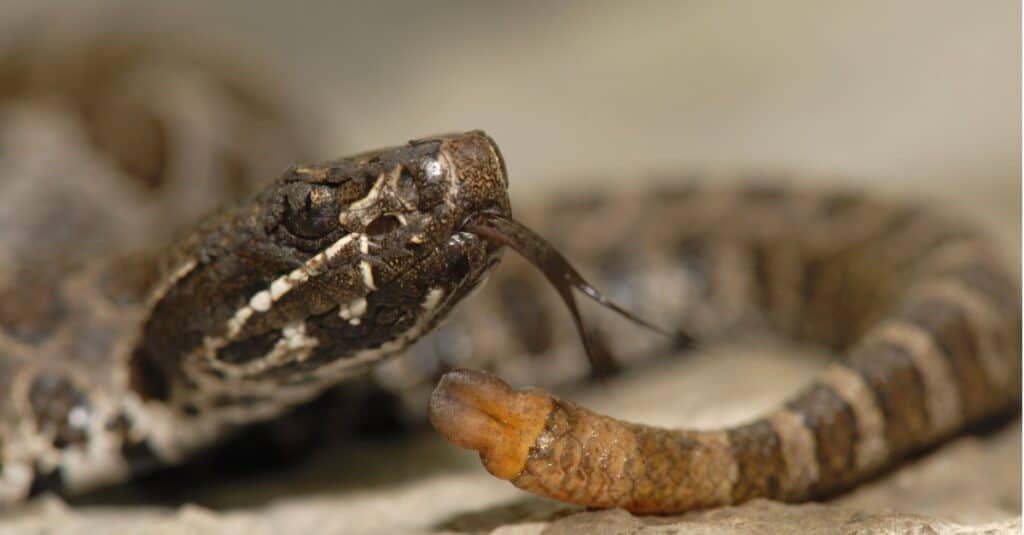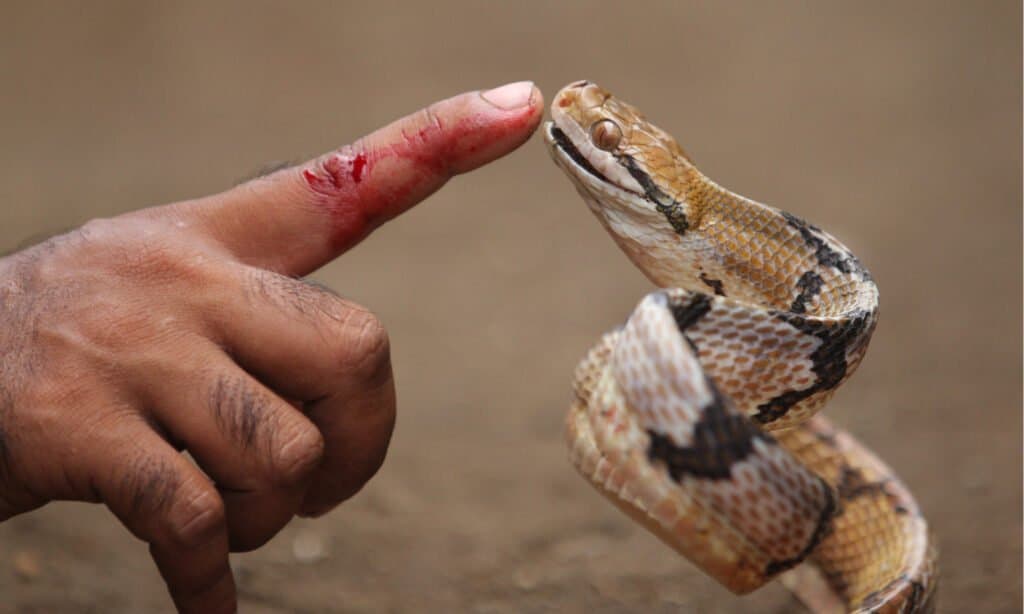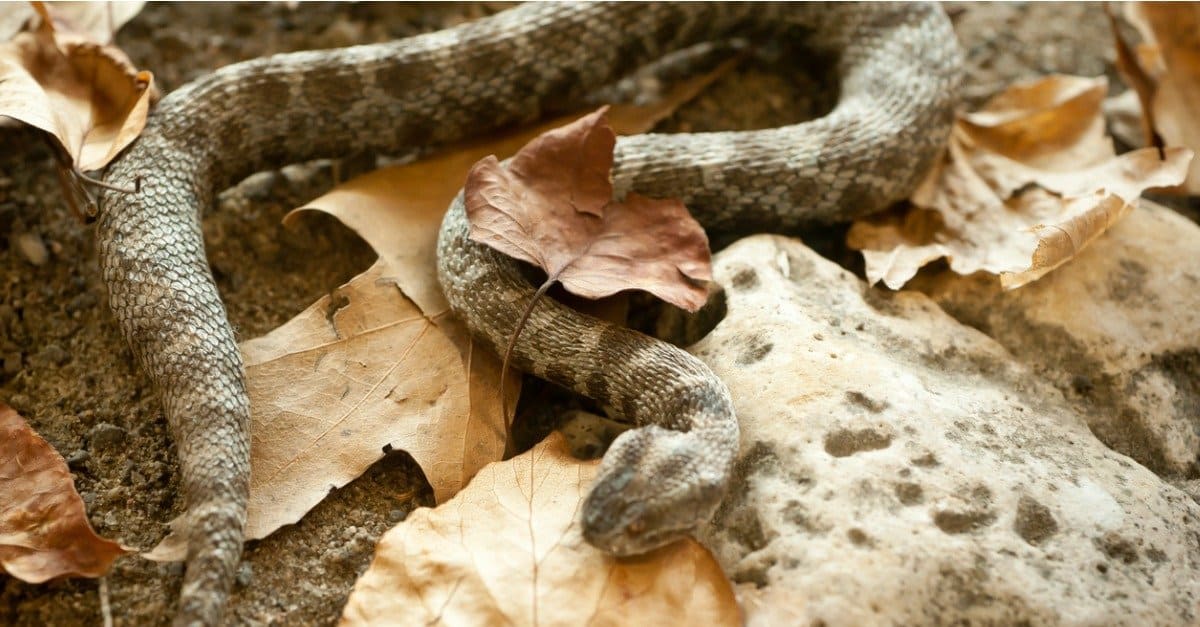Michigan is renowned for its beautiful wild areas and proximity to the Great Lakes. While many people appreciate the abundant fish and mammals to hunt, there are also many different snakes in this part of the country. Fortunately, this state is not home to many venomous snakes. Take a look at the poisonous snakes in Michigan and see which of these reptiles you should avoid.
How Many Types of Snakes Live in Michigan?

The blue racer resembles a venomous snake, but it’s not venomous.
©Psychotic Nature/Shutterstock.com
Michigan is home to 18 different types of snakes, and they range in size, location, and potential danger. While there are some poisonous snakes in Michigan, the majority of Michigan snakes pose little danger to humans, and they would rather slither away than get harmed by a human.
However, some of the non-venomous snakes in Michigan tend to look or act like venomous ones. For example, many people that see the northern watersnake will believe that it’s the cottonmouth snake. The cottonmouth snake is deadly, but the northern watersnake is not. Furthermore, the cottonmouth is not found in Michigan.
People often confuse the eastern hog-nosed snake for a venomous snake, even though it is not deadly to humans. This confusion stems from its threat display where the reptile opens its mouth.
Lastly, the blue racer looks like it could be a venomous snake, and it’s rumored to be aggressive and capable of chasing people. However, this snake is not venomous and barely poses a threat to humans in Michigan.
How Many Poisonous Snakes in Michigan Exist?

The Massasauga
rattlesnake
is the only venomous snake in Michigan.
©iStock.com/Shoemcfly
One poisonous species of snake lives in Michigan. This snake is called the eastern massasauga. Ignoring the unusual name, the snake is actually a member of the rattlesnake family.
Rattlesnakes are dangerous animals that have hemotoxic venom. This venom can easily kill human beings if they are bitten. Although some rattlesnakes deliver dry bites, over 60% of bites contain venom.
The eastern massasauga is the only snake that people need to worry about in terms of envenomation. Let’s take a closer look at this snake.
About the Eastern Massasauga: The Only Venomous Snake in Michigan

Massasaugas have colors and markings that include tan, gray, or brown with dark brown or black splotches.
©Rusty Dodson/Shutterstock.com
Eastern Massasauga
| Size | Color | Unique Factors |
|---|---|---|
| – 2ft-2.5ft long | – Brownish-gray, brown, gray – Brown or dark brown splotches on its back | – Has a rattle on the end of its tail – Snake will shake its rattle |
The eastern massasauga is a small rattlesnake. The snake is listed as threatened and is becoming a rarer sight around the state. While that might be a relief for humans, all animals play an important role in the ecology of the area. Snakes, in general, are valuable assets to help keep rodent populations down. The eastern massasaga’s main diet consists of mice, moles, voles, and shrews.
The eastern massasauga is short, but its body is similar to other rattlesnakes, becoming thicker in the middle before tapering off at the end. This pit viper is sometimes called the “swamp rattlesnake” because of its propensity to live in wetlands.
The eastern massasauga is not aggressive towards humans. In fact, it’s a timid snake that would rather run and hide than take on one of us. However, if threatened, this type of snake may choose to lie still, seeking to blend into its environment. It may shake its rattle, or just strike immediately if the situation calls for it. Its rattle is different than the typical sound of most rattlesnakes. It sounds more like the buzz of a bee.
Individuals that are fishing are most likely to encounter this snake anywhere in the state. The snake’s range is shrinking, encounters are becoming rarer, and envenomations are highly unlikely.
How Many People Die from Poisonous Snakes in Michigan?

On average, zero people per year die from venomous snakebites in Michigan.
©Mufti Adi Utomo/Shutterstock.com
Very few people die as a result of snakebites in Michigan. Although the late 2010s witnessed a few rattlesnake bites in Michigan, no deaths from those bites were recorded. Thus, a yearly average of zero fatal snakebites occur in Michigan every year.
About 7,000-8,000 venomous snakebites occur throughout the United States every year. Due to the high treatability of these bites through medical intervention and antivenom, only about five people die every year in the entire country.
The chances are low that you will be bitten by a venomous snake in Michigan. Even if you are bitten by the eastern massasauga, you have a high chance of surviving the bite.
Other Venomous Snakes in the United States

Eastern coral snakes
typically have black coloring until right behind the eyes.
©Jay Ondreicka/Shutterstock.com
The United States is home to four different genera of venomous snakes. They include rattlesnakes, copperheads, cottonmouths, and coral snakes. Let’s take a closer look at each of them, so you know what to expect from these dangerous animals.
Rattlesnake
| Size | Color | Unique Factors |
|---|---|---|
| 3ft-7ft long | – Dark zig-zag patterns set against brown, gray, or pinkish skin | – Known for its rattle and S-shaped defense posture |
Rattlesnakes like the massasauga are very widespread and dangerous snakes, as we’ve said throughout this article. These animals are known for their rattles and various patterns, especially on the diamondback rattlesnakes. They can vary in length, but their rattles make them distinct.
Coral Snake
| Size | Color | Unique Factors |
|---|---|---|
| – Thin, small snake that usually grows to be about 2ft long – May reach 4ft long | – Red, black, and yellow in distinctive band – Yellow bands are usually thin | – They bite and chew their foe instead of using hollowed fangs |
Coral snakes are among the rarest venomous snakes in the United States. However, they also have very potent venom. The coral snake is often confused for the kingsnake due to their banding. Your best bet is to leave these snakes alone if you’re not entirely sure of their species.
Copperhead
| Size | Color | Unique Factors |
|---|---|---|
| 2ft-4ft long | – Brown, tan, yellow – Dark brown or red hourglass-shaped blotches on its back – Blend in well with leaves and soil | – Great camouflage and widespread |
Copperheads are dangerous creatures because they blend in with dirt, leaves, and other debris. These snakes have a large range within the United States. They’re shy and tend to flee rather than fight. However, if they are stepped on, they will strike.
Although copperheads will sometimes move their tails like they’re a rattlesnake, their venom is not as medically significant.
Cottonmouth
| Size | Colors | Unique Factors |
|---|---|---|
| – Between 2-3ft long – May grow up to 5ft long | – Olive, black, brown | – Have a white mouth that they show when threatened – Patch of white on the chin – Arrow-shaped head |
Cottonmouth snakes are often found near water, and they’re known for opening their mouths as part of their threat display. When they open their mouths, you’ll see all white. That’s how they got their name. These snakes are rumored to be aggressive, but they’re just as likely to leave you alone. They’re found near water, but they are not found in Michigan.
Cottonmouths are spread throughout the United States. Few states do not have any venomous snakes in them at all. As long as you are aware of the deadly snakes in your area, you’ll have a very good chance of avoiding them and any injuries.
Bonus: Are There Eastern Massasauga Rattlesnakes in Canada?

The range of eastern Massasauga rattlesnakes extends north of Michigan into areas of Ontario, Canada that border Lake Huron and Lake Erie.
©Vladislav T. Jirousek/Shutterstock.com
As Michigan borders three of the Great Lakes (Michigan, Huron, and Erie), and Ontario, Canada borders Michigan to the north, would it be safe to assume that these venomous snakes extend into Canada?
The answer is yes! Eastern Massasauga rattlesnakes have been found in the Wainfleet Bog on the northeast shores of Lake Erie, as well as the eastern side of Georgian Bay and the Bruce Peninsula of Lake Huron. This threatened species is the only venomous snake you’d find in or around those two Great Lakes, either in Canada or in Michigan.
Discover the "Monster" Snake 5X Bigger than an Anaconda
Every day A-Z Animals sends out some of the most incredible facts in the world from our free newsletter. Want to discover the 10 most beautiful snakes in the world, a "snake island" where you're never more than 3 feet from danger, or a "monster" snake 5X larger than an anaconda? Then sign up right now and you'll start receiving our daily newsletter absolutely free.
Thank you for reading! Have some feedback for us? Contact the AZ Animals editorial team.








